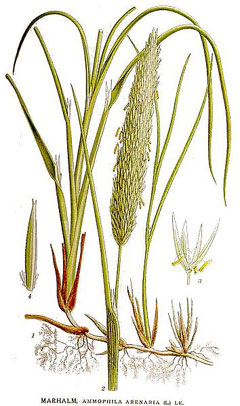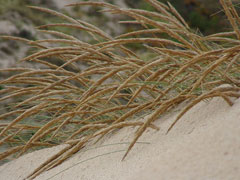 |
|
http://commons.wikimedia.org/wiki/File:468_Ammophila_arenaria.jpg |
 |
| http://commons.wikimedia.org/wiki/User:Tintazul |
Translate this page:
Summary
Native to the coastlines of Europe and North Africa where it grows in the sands of beach dunes. Some very useful applications including Basketry; Broom; Fibre; Paper; Soil stabilization; Thatching; and Weaving.
Physical Characteristics

 Ammophila arenaria is a PERENNIAL growing to 1.2 m (4ft).
Ammophila arenaria is a PERENNIAL growing to 1.2 m (4ft).
See above for USDA hardiness. It is hardy to UK zone 5. It is in flower from July to August, and the seeds ripen from August to September. The species is hermaphrodite (has both male and female organs) and is pollinated by Wind.
Suitable for: light (sandy) and medium (loamy) soils, prefers well-drained soil and can grow in nutritionally poor soil. Suitable pH: mildly acid, neutral and basic (mildly alkaline) soils and can grow in very acid soils.
It cannot grow in the shade. It prefers dry or moist soil and can tolerate drought. The plant can tolerate maritime exposure.
UK Hardiness Map
US Hardiness Map
Synonyms
A. arundinacea. Psamma arenaria.
Plant Habitats
Cultivated Beds;
Edible Uses
Edible Parts: Root
Edible Uses:
Root[74]. No more details, but the root is rather thin and fibrous[K].
References More on Edible Uses
Medicinal Uses
Plants For A Future can not take any responsibility for any adverse effects from the use of plants. Always seek advice from a professional before using a plant medicinally.
None known
References More on Medicinal Uses
The Bookshop: Edible Plant Books
Our Latest books on Perennial Plants For Food Forests and Permaculture Gardens in paperback or digital formats.

Edible Tropical Plants
Food Forest Plants for Hotter Conditions: 250+ Plants For Tropical Food Forests & Permaculture Gardens.
More

Edible Temperate Plants
Plants for Your Food Forest: 500 Plants for Temperate Food Forests & Permaculture Gardens.
More

More Books
PFAF have eight books available in paperback and digital formats. Browse the shop for more information.
Shop Now
Other Uses
Basketry Broom Fibre Paper Soil stabilization Thatching Weaving
The flowering stems and leaves are used for thatching, in basketry, making brooms etc[61, 66, 100]. The rhizomes are used for making rope and mats[115]. A fibre obtained from the stems is used for making paper[189]. The stems are harvested in the summer, cut into usable pieces and soaked for 24 hours in clear water before cooking for 2 hours with soda ash. Beat the fibres in a ball mill for 1½ hours. The fibres make a tan-brown paper[189]. This plant has an extensive root system and grows naturally in sand dunes along the coast where it is very important for its action of binding the dunes and therefore allowing other plants to grow. It is much planted in sand dunes and other similar habitats for erosion control[200].
Special Uses
References More on Other Uses
Cultivation details
Requires a sunny position in a light well-drained soil. Very tolerant of severe maritime exposure[17]. Tolerates a pH in the range 4.5 to 6.8.
References Carbon Farming Information and Carbon Sequestration Information
Temperature Converter
Type a value in the Celsius field to convert the value to Fahrenheit:
Fahrenheit:
The PFAF Bookshop
Plants For A Future have a number of books available in paperback and digital form. Book titles include Edible Plants, Edible Perennials, Edible Trees,Edible Shrubs, Woodland Gardening, and Temperate Food Forest Plants. Our new book is Food Forest Plants For Hotter Conditions (Tropical and Sub-Tropical).
Shop Now
Plant Propagation
Seed - sow in pots outdoors as soon as it is ripe or sow in situ during March/April. Division in spring or autumn.
Other Names
If available other names are mentioned here
Native Range
EUROPE: Denmark, Finland, United Kingdom, Norway, Germany, Netherlands, Spain, France
Weed Potential
Right plant wrong place. We are currently updating this section.
Please note that a plant may be invasive in one area but may not in your area so it's worth checking.
Some indication that it is invasive in California, USA.
Conservation Status
IUCN Red List of Threatened Plants Status : This taxon has not yet been assessed.

Growth: S = slow M = medium F = fast. Soil: L = light (sandy) M = medium H = heavy (clay). pH: A = acid N = neutral B = basic (alkaline). Shade: F = full shade S = semi-shade N = no shade. Moisture: D = dry M = Moist We = wet Wa = water.
Now available:
Food Forest Plants for Mediterranean Conditions
350+ Perennial Plants For Mediterranean and Drier Food Forests and Permaculture Gardens.
[Paperback and eBook]
This is the third in Plants For A Future's series of plant guides for food forests tailored to
specific climate zones. Following volumes on temperate and tropical ecosystems, this book focuses
on species suited to Mediterranean conditions—regions with hot, dry summers and cool, wet winters,
often facing the added challenge of climate change.
Read More
Expert comment
Author
(L.)Link.
Botanical References
17200
Links / References
For a list of references used on this page please go here
Readers comment
| Add a comment |
|
If you have important information about this plant that may help other users please add a comment or link below. Only comments or links that are felt to be directly relevant to a plant will be included. If you think a comment/link or information contained on this page is inaccurate or misleading we would welcome your feedback at [email protected]. If you have questions about a plant please use the Forum on this website as we do not have the resources to answer questions ourselves.
* Please note: the comments by website users are not necessarily those held by PFAF and may give misleading or inaccurate information.
To leave a comment please Register or login here All comments need to be approved so will not appear immediately.
|
Subject : Ammophila arenaria
|
|
|
|